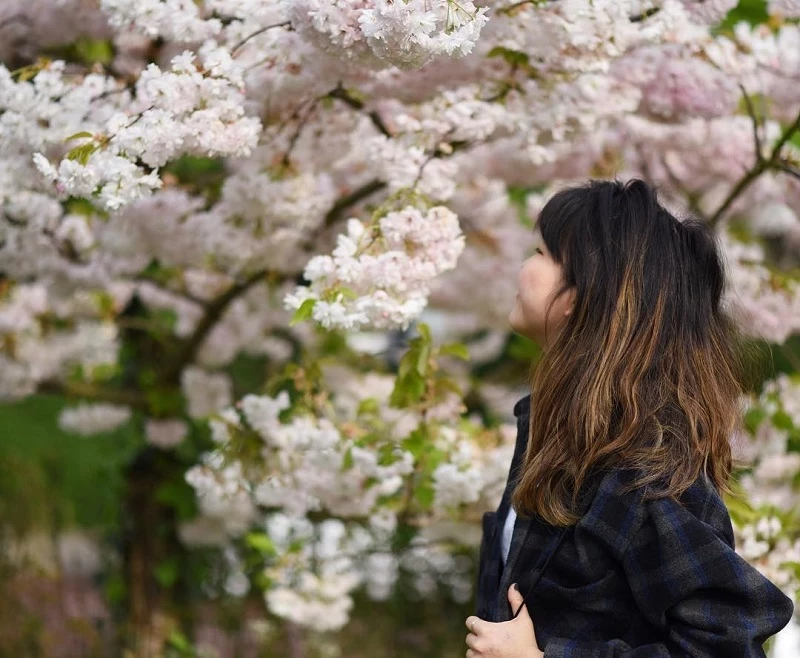
Ten things you might not know about cherry trees
The different varieties of cherry trees around the Royal Parks are some of the most popular sights in London each spring.
The Royal Park's cherry trees were added to in autumn 2019 when 125 new cherry trees were planted in the Royal Parks, a gift from Japan as part of the Japan-UK Season of Culture 2019-20. With spring 2024 set to feature some amazing displays of colour, here are ten facts you might not know about the spectacular cherry trees.
1. Not all cherry trees bear fruit
In fact many ornamental varieties have been bred to produce more flowers and, in some cases, don’t produce fruit at all. Most of the flowering cherry trees we see in UK parks and streets are valued for their flowers, with the cherries they produce small and bitter – not great for people but a good snack for the birds.

2. You can eat the blossom
That’s right, the cherry blossoms (and leaves) of varieties we find in the UK are edible. In Japan they’re pickled and used as ingredients for sweets, baking and tea. Come springtime you’ll also find akura-flavoured chocolate bars. Don’t eat cherry pips though, they’re toxic and can be dangerous in large amounts and please don't pick the blossom from the trees in the Royal Parks!

3. Cherry trees are found around the world
There are flowering cherry trees in countries across the globe, including America, Korea, Brazil and India, with many originating through links with Japan. The UK’s cherry tree population rose in the last few years as another 6,500 new trees were planted across the UK as part of the Japan-UK Season of Culture 2019-20, gifts from Japan to celebrate the relationship between the two countries.

4. Not all cherry blossom is pink
While pink is the colour most people associate with cherry blossom, it tends to change from dark pink, to light pink, to white when fully in bloom. Some varieties even begin as a greenish yellow colour before changing to white and then to pink.

5. Blossoms are here one day, gone the next
Cherry trees generally tend to bloom for only a week or two each spring. This could be even shorter if seasonal wind or rain knocks the blossoms from the trees. In the Royal Parks the parakeets and other birds are fond of the blossom as a tasty treat. It’s one of the things that makes the cherry blossom so special – catch it while you can because it won’t be around for long.

6. Cherry trees don't live long
Across all varieties cherry trees tend to have a short lifespan, typically around 15-30 years. However black cherry trees can live for anything up to 250 years. The oldest known cherry tree is the famous Jindai Zakura in Japan – still flowering every spring an estimated 2,000 years since it was planted.

7. An Englishman saved one of Japan’s favourite cherry trees
Collingwood “Cherry” Ingram was an expert gardener with a passion for flowering cherry trees. While on a trip to Japan in 1926 he was shown a painting of a beautiful cherry tree with white blossom, believed to have died out in Japan. Ingram recalled having taken cuttings from a tree of the same species in a garden in Sussex and managed to reintroduce the Great White Cherry, or Taihaku, to Japan. Five Great White Cherry trees will be planted in The Regent's Park for the Japan-UK Season of Culture 2019-20.

8. The cherry blossom capital of the world is not in Japan
It's in a town called Macon in the state of Georgia, America. In 1952 a local resident discovered one Yoshino cherry tree and loved it so much that he learned to propagate the trees and gifted them to his community. Macon now has over 350,000 Yoshino cherry trees flowering at their annual blossom festival.

9. Cherry blossoms bring people together each spring
In the Royal Parks in London, cherry trees are up there with ducklings and daffodils as the most Insta-worthy spring scenes around. In Japan theseasonal wave of pink and white that sweeps from the south to the north of the country is arguably the highlight of the year. People gather under the blossoms to share food and drink for hanami, a centuries-old flower viewing tradition. It's something that has also become popular in some of London's parks in recent years.

10. Cherry blossoms symbolise more than just a new season
In Japan many schools and businesses have a cherry tree in front of their building. The financial year and the school year both start in April, with the blooming trees a symbol of renewal and a fresh start. In public parks people gather under the branches, eating and drinking, appreciating the fleeting beauty of life with friends and family. The short-lived hanami celebrations are a reminder to seize the day.

Related Articles
-
 Listen
ListenDawn Chorus
Tune in to learn more about what Dawn Chorus is and why it only happens during a short window in spring.
-
 Read
ReadWhat can you spot? A guide to the birds of the Royal Parks
With this bird spotter guide, you can have a go at identifying some of these wonderful creatures while you enjoy a walk around the parks in London.
-
 Read
Read'The Lay of the Old Hollow Tree'
An atmospheric poem about Queen Elizabeth’s Oak appeared in the West Kent Guardian on 2 July 1853.